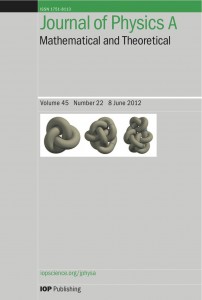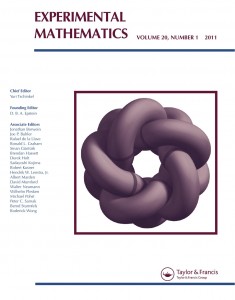To obtain a copy of any of the papers listed below, click on the title of the paper. The preprints should be cited by arXiv number (as they are all also available from the arXiv). You can get citation information for these papers from my Google author profile if you’re interested. The BibTeX citation information for all the papers is collected in cantarella.bib.
- CoBarS: Fast reweighted sampling for polygons in any dimension.
Jason Cantarella and Henrik Schumacher.
arXiv preprint 2310.19134
C++ implementation on GitHub
Mathematica interface to library on GitHub - A faster direct sampling algorithm for equilateral polygons.
Jason Cantarella, Henrik Schumacher, and Clayton Shonkwiler.
arXiv preprint 2309.10163 - Random graph embeddings with general edge potentials.
Jason Cantarella, Tetsuo Deguchi, Clayton Shonkwiler and Erica Uehara.
arXiv preprint 2205.09049 - Exact Evaluation of the Mean Square Radius of Gyration for Gaussian Topological Polymer Chains.
Jason Cantarella, Tetsuo Deguchi, Clayton Shonkwiler and Erica Uehara.
in Topological Polymer Chemistry, Tezuka and Deguchi, eds, Springer, 2021. - Forum of Mathematics, Sigma 10 (2022) , e101.Jason Cantarella, Elizabeth Denne, and John McCleary.
- Square-like quadrilaterals inscribed in embedded space curves.
Jason Cantarella, Elizabeth Denne, and John McCleary.
arXiv preprint 2103.13848 - Configuration Spaces, Multijet Transversality, and the Square-Peg Problem.
Jason Cantarella, Elizabeth Denne, and John McCleary.
Illinois Journal of Mathematics 66 (2022), no. 3, p. 385–420. - Performance of the Uniform Closure Method for open knotting as a Bayes-type classifier.
Emily Tibor, Elizabeth Annoni, Erin Brine-Doyle, Nicole Kumerow, Madeline Shogren, Jason Cantarella, Clayton Shonkwiler, and Eric Rawdon.
arXiv preprint 2011.08984 - Radius of Gyration, Contraction Factors, and Subdivisions of Topological Polymers.
Jason Cantarella, Tetsuo Deguchi, Clayton Shonkwiler, and Erica Uehara.
Journal of Physics A 55 (2022), no. 47, p. 475202. - Computing the Conformal Barycenter.
Jason Cantarella and Henrik Schumacher.
SIAM Journal on Applied Algebra and Geometry 6 (2022), no. 3, p. 503-530.
Mathematica implementation on GitHub. - Gaussian Random Embeddings of Multigraphs.
Jason Cantarella, Tetsuo Deguchi, Clayton Shonkwiler, and Erica Uehara.
arXiv preprint 2001.11709 - Open and closed random walks with fixed edgelengths in R^d
Jason Cantarella, Kyle Chapman, Philipp Reiter, and Clayton Shonkwiler.
Journal of Physics A 51 (2018), no. 43, p. 434002 - Random Triangles and Polygons in the Plane.
Jason Cantarella, Thomas Needham, and Clayton Shonkwiler.
American Mathematical Monthly 126 (2019), no. 2, p.113-134 - Knot Fertility and Lineage.
Jason Cantarella, Allison Henrich, Elsa Magness, Oliver O’Keefe, Kayla Perez, Eric Rawdon, Brianna Zimmer.
Journal of Knot Theory and Its Ramifications 26 (2017), no. 13, p. 1750093 - Knot Probabilities in Random Diagrams.
Jason Cantarella, Harrison Chapman and Matt Mastin.
Journal of Physics A 49 (2016), p. 405001
This paper comes with a tabulation of knot diagrams up to 10 crossings (including pictures) as supplementary data (53M). - A Fast Direct Sampling Algorithm for Equilateral Closed Polygons.
Jason Cantarella, Bertrand Duplantier, Clayton Shonkwiler and Erica Uehara.
Journal of Physics A 49 (2016), no. 27, p. 275205.
This paper was one of the highlights of the year for 2016 in Mathematical Physics. - Rigid Origami Vertices: Conditions and Forcing Sets.
Zachary Abel, Jason Cantarella, Erik D. Demaine, David Eppstein, Thomas C. Hull, Jason S. Ku, Robert J. Lang, Tomohiro Tachi.
Journal of Computational Geometry 7 (2016), no. 1, p. 171-184. - Transversality in Configuration Spaces and the Square Peg Problem.
Jason Cantarella, Elizabeth Denne and John McCleary.
arXiv:1402.6174 - The Symplectic Geometry of Closed Equilateral Random Walks in 3-space
Jason Cantarella and Clayton Shonkwiler.
Annals of Applied Probability 26 (2016), no. 1, p. 549-596
A 30-minute talk on this paper for physicists and biologists
Slides from the talk - The tight knot spectrum in QCD.
Roman Buniy, Jason Cantarella, Thomas Kephart and Eric Rawdon.
Physical Review D 89 (2014), no. 5, p. 054513
PhysRevD.89.054513
This paper comes with a data set of tight knot and link vertex coordinates and summary data (including prime and composite knots and links and curvature information) and a low-resolution archive of tight knot and link vertex coordinates. - The Expected Total Curvature of Random Polygons.
Jason Cantarella, Alexander Y Grosberg, Robert B Kusner and Clayton Shonkwiler.
American Journal of Mathematics 137, (2015), no. 2, p. 411-438 .
arXiv:1210.6537.
2012arXiv1206.3161C - Symmetric Criticality for Tight Knots.
Jason Cantarella, Jennifer Ellis, Joseph H.G. Fu and Matt Mastin.
Journal of Knot Theory and its Ramifications 23 (2014), 1450008-1-17
arXiv:1208.3879.
doi:10.1142/S0218216514500084 - Probability Theory of Random Polygons from the Quaternionic Viewpoint.
Jason Cantarella, Tetsuo Deguchi and Clayton Shonkwiler.
Communications on Pure and Applied Mathematics 67 (2014), no. 10, p. 1658-1699.
CPA:CPA21480
ANSI C code for generating random polygons according to the methods of this paper is included in our plCurve library. - Ropelength Criticality.
Jason Cantarella, Joseph H.G. Fu, Rob Kusner, John Sullivan.
Geometry and Topology 18 (2014), no. 4, p. 1973-2043.
gtropelengthcriticality - The 27 possible intrinsic symmetry groups of 2-component links.
Jason Cantarella, James Cornish, Matt Mastin and Jason Parsley.
Symmetry 4 (2012), no. 1, p. 129-142
sym4010129 - The Shapes of Tight Composite Knots
Jason Cantarella, Al LaPointe and Eric Rawdon.
J. Phys A: Math Theor. 45 (2012), p. 1-19
arXiv:1110.3262
1751-8121-45-22-225202
This paper comes with several data files: tight knot and link vertex coordinates (including prime and composite knots and links and curvature information) and a low-resolution version of tight knot and link vertex coordinates. This data was generated with support from NSF grants 1115722 and 0810415 (to Rawdon). This paper was the source of the cover image of the Journal of Physics A the month it was published
- Intrinsic Symmetry Groups of Links with 8 and fewer crossings
Michael Berglund, Jason Cantarella, Meredith Perrie Casey,
Ellie Dannenberg, Whitney George, Aja Johnson, Amelia Kelly,
Al LaPointe, Matt Mastin, Jason Parsley, Jacob Rooney and Rachel Whitaker.
Symmetry 4 (2012), no. 1, p. 143-207.
arXiv:1010.3234 sym4010143 - Knot Tightening by Constrained Gradient Descent.
Ted Ashton, Jason Cantarella, Michael Piatek, and Eric Rawdon.
Experimental Mathematics 20 (2011), no. 1, p. 57-90.
arXiv:1002.1723
acprtightening
See also Self contact sets for 50 Tightly Knotted and Linked Tubes, which is an early version of this paper. The data sets corresponding to this paper are the Atlas of Tight Knots and Links, the archive of Tight Knot and Link Vertex Coordinates and a text file summary of ropelengths for knots and links. This paper was the source of the cover image for Experimental Math when published:
- A new cohomological formula for helicity in $\R^{2k+1}$ reveals the effect of a diffeomorphism on helicity.
Jason Cantarella and Jason Parsley.
Journal of Geometry and Physics 60 (2010), p. 1127-1155.
arxiv: math.GT/09031465
Cantarella20101127 - Criticality for the Gehring Link Problem.
Jason Cantarella, Joseph H.G. Fu, Rob Kusner, John M. Sullivan, and Nancy Wrinkle.
Geometry and Topology 10 (2006), p. 2055-2116.
arXiv: math.DG/0402212
MR2284052 - On Comparing the Writhe of a Smooth Curve to the Writhe of an Inscribed Polygon.
Jason Cantarella.
SIAM Journal of Numerical Analysis 42 (2005) no. 4, p. 1846-1861.
arXiv: math.DG/0202236
MR2139226 - Visualizing the tightening of knots
Jason Cantarella, Michael Piatek, and Eric Rawdon.
Proceedings of IEEE Visualization 2005, p. 575-582.
cprvis - A fast octree-based algorithm for computing ropelength
Ted Ashton and Jason Cantarella
In Physical and Numerical Models in Knot Theory
and their Application to the Life Sciences,
World Scientific Press (2005), p. 323-341
arxiv
MR2197947
This is the algorithm implemented by the Octrope library. - TSNNLS: A solver for large sparse least squares problems with non-negative variables
Jason Cantarella and Michael Piatek.
Unpublished (2004).
arxiv:cs.MS/0408029
tsnnls
This unpublished manuscript describes the algorithm implemented in our open-source TSNNLS library. The library is used around the world for solving sparse constrained least squares problems of moderate size (matrices dimensions of a few thousand by a few thousand). TSNNLS was very fast for its day, but it is not an actively updated package and it is probably somewhat behind the times at this point. If you want to do more general or much larger problems of this type, I’d look at the COIN-OR project (specifically IpOPT). - An Energy-Driven Approach to Linkage Unfolding.
Jason Cantarella, Erik Demaine, Hayley Iben and James O’Brien.
SCG ’04: Proceedings of the twentieth annual symposium on Computational geometry, p. 134-143
Abstract (not posted) in Proceedings of the 12th Annual DIMACS Fall Workshop
on Computational Geometry, Piscataway, New Jersey, November 14-15, 2002.
James O’Brien and Hayley Iben prepared some cool movies and wrote a nice Java applet to demonstrate some of the results from this paper. Here are some updated video files showing the unfolding - Upper Bounds for Ropelength as a function of Crossing Number.
Jason Cantarella, X.W. Faber, and Chad A. Mullikin.
Topology and its Applications 135 (2003), no. 1-3, p. 253-264.
arXiv: math.GT/0210245
Cantarella2004253 - The Second Hull of a Knotted Curve.
Jason Cantarella, Greg Kuperberg, Robert B. Kusner, and John M. Sullivan.
American Journal of Mathematics 125 (2003) no. 6, p. 1335-1348.
arXiv: math.GT/0204106
MR2018663 - Vector Calculus and the Topology of Domains in 3-Space.
Jason Cantarella, Dennis DeTurck, and Herman Gluck.
American Mathematical Monthly 109 (2002) no. 5. p. 409-442
MR2003c:53023 - On the Minimum Ropelength of Knots and Links.
Jason Cantarella, Robert B. Kusner, and John M. Sullivan.
Inventiones Mathematicae 150 (2002) no. 2, p. 257-286.
MR2003h:58014 - Circles Minimize Most Knot Energies.
Aaron Abrams, Jason Cantarella, Joe Fu, Mohammad Ghomi, and Ralph Howard.
Topology 42 (2002) no. 2, p. 381-394.
MR2004f:58014
This paper was one of the 5 most downloaded articles in the journal Topology during January-August of 2004. - The Biot-Savart operator for application to knot theory, fluid dynamics, and plasma physics
Jason Cantarella, Dennis DeTurck, and Herman Gluck.
Journal of Mathematical Physics 42 (2001), no. 2, p. 876-905.
MR2002e:78002 - Isoperimetric problems for the helicity of vector fields and the Biot-Savart and curl operators
Jason Cantarella, Dennis DeTurck, Herman Gluck, and Mikhail Teytel.
Journal of Mathematical Physics 41 (2000), no. 8, p. 5615-5641.
MR2001f:78010 - A General Cross-Helicity Formula
Jason Cantarella.
Proceedings of the Royal Society, Series A 456 (2000) no. 2003, p. 2771-2779
MR2002f:53002 - Upper Bounds for the Writhing of Knots and the Helicity of Vector Fields
Jason Cantarella, Dennis DeTurck, and Herman Gluck.
Proceedings of the Conference in Honor of the 70th Birthday of Joan Birman
Jane Gilman, Xiao-Song Lin, William Menasco (eds)
International Press, AMS/IP Series on Advanced Mathematics (2000)
MR2003j:58018 - Eigenvalues and Eigenfields of the Biot-Savart and Curl Operators on Spherically Symmetric Domains
Jason Cantarella, Dennis DeTurck, Herman Gluck, and Misha Teytel.
Physics of Plasmas 7(7), 2000. pp.2766-2775.
MR2001b:76094 - Influence of Geometry and Topology on Helicity
Jason Cantarella, Dennis DeTurck, Herman Gluck, and Misha Teytel.
In Magnetic Helicity in Space and Laboratory Plasmas,
Michael Brown, Richard Canfield and Alexei Pevtsov (eds),
Geophysical Monographs 111, American Geophysical Union. (1999)
influence - Topological Structure of Stable Plasma Flows
Jason Cantarella.
Ph.D. Thesis, University of Pennsylvania, 1999.
cantarellathesis - Tight Knot Values Deviate From Linear Relation
Jason Cantarella, Robert B. Kusner, and John M. Sullivan.
Nature 392, March 19, 1998, p. 237.
cksnature - Nontrivial Embeddings of Polygonal Intervals and Unknots in 3-Space
Jason Cantarella and Heather Johnston.
Journal of Knot Theory and its Ramifications, Vol. 7, No. 8 (1998) p. 1027-1039.
MR99m:57002 - The Principal Eigenvalue of the Curl Operator on the Flat Torus
Jason Cantarella, Dennis DeTurck, and Herman Gluck.
Unpublished preprint circa 1996
These works were produced under the “general obligation to produce scholarly and creative works” and copyright is retained by the authors or assigned to publishers per individual agreements.



